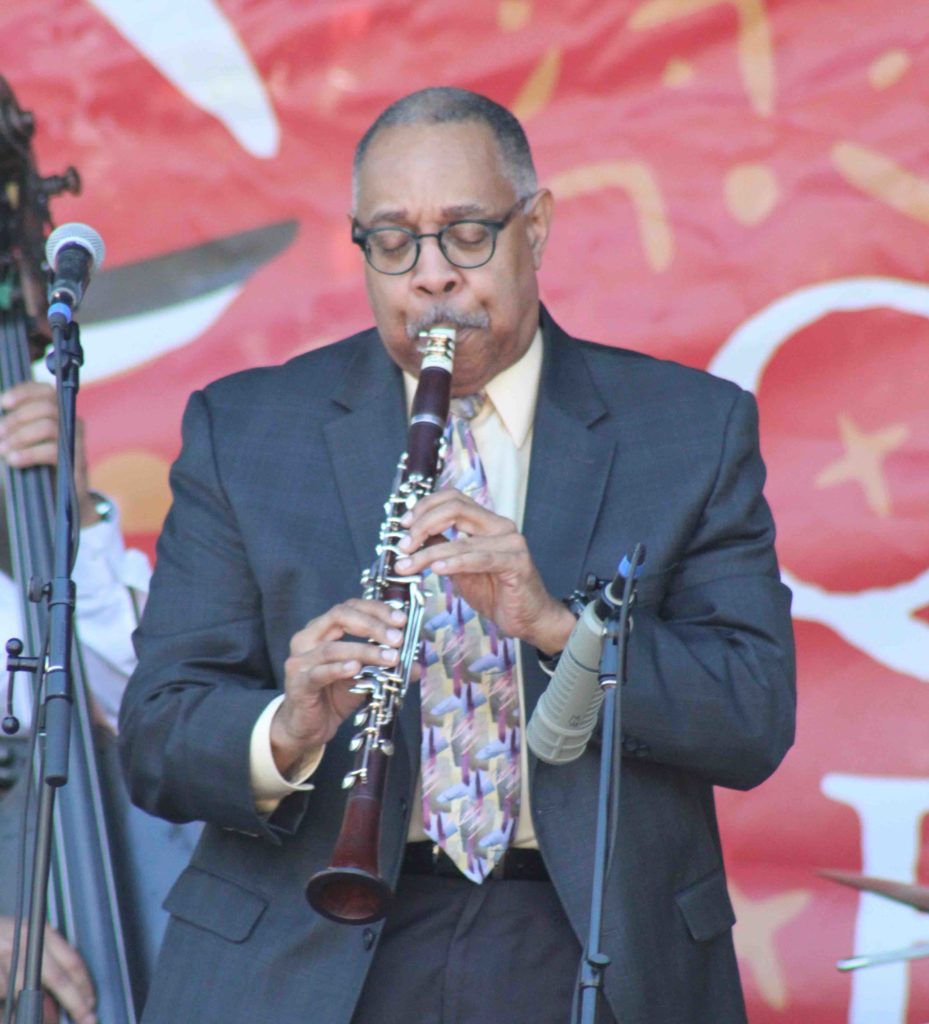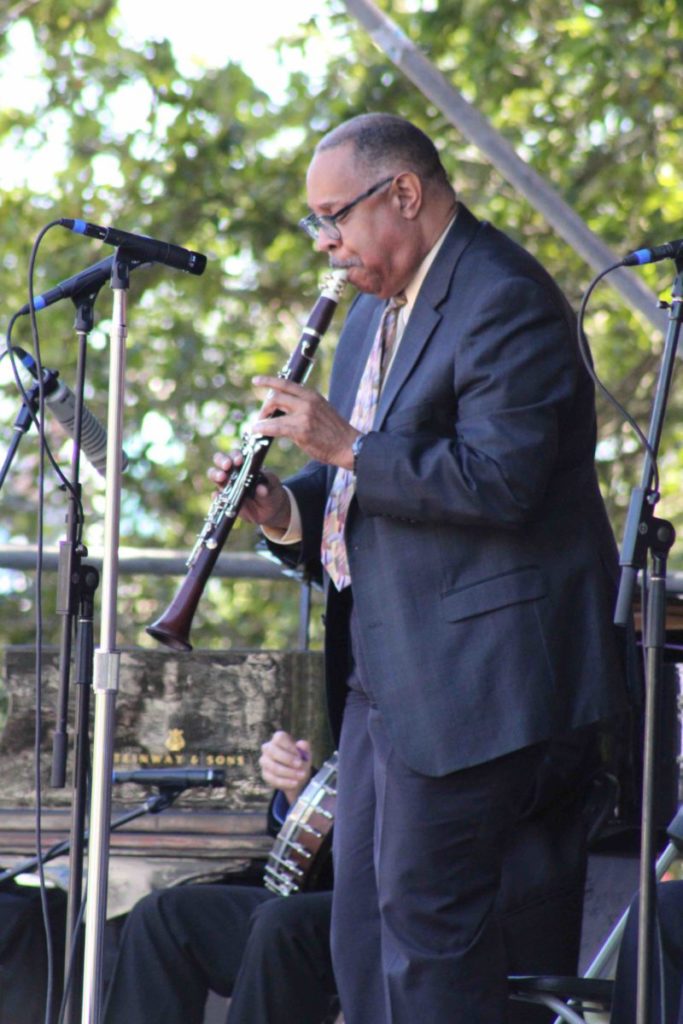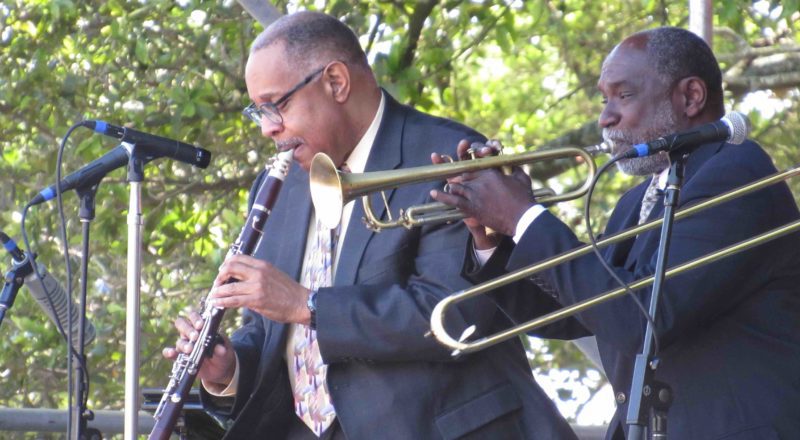INTERVIEW: Dr. Michael White, the musician who ventures deep into NOLA jazz history
Photo: Dr. Michael White and his band have several recording efforts, including Doctor Michael White Live. Photo by John Soltes.
There are jazz musicians, and then there’s Dr. Michael White. The studious and dedicated clarinetist lives up to his “Doctor” billing as perhaps the most respected and revered player of his chosen instrument on the New Orleans music scene.
Basin Street Records was smart to sign him to a multi-album deal a few years ago, and both have profited from the relationship. Now artist and label have come together for a special release celebrating the 20th anniversary of BSR.
Doctor Michael White Live was recently released digitally (plans for physical copies are in the works). The recording captures the night when Basin Street rented out the legendary Little Gem Saloon in New Orleans’ CBD for an evening of nostalgic music and interesting collaborations. White’s set from the night has been preserved by the new album, a recording that also features Gregory Stafford, Seva Venet, Mark Brooks and Jason Marsalis.
The five selections on the live album are “Canal Street Blues,” an old King Oliver tune that White makes a 10-minute opus; “I Love You Too Much to Ever Leave You” and “Caribbean Girl (A New Orleans Calypso),” both penned by White himself; the Gershwins’ classic “Summertime”; and “Give It Up (Gypsy Second Line),” another original tune.
[Read Hollywood Soapbox’s previous interview with Dr. Michael White.]
“Well, it was nice to celebrate Basin Street’s anniversary,” White said in a recent phone interview. “It was hard to believe that that much time had passed. I think 20 years. It was a special night because I’m not that big on a lot of the more commercial clubs in terms of performance, but I like playing at Snug Harbor in New Orleans and the Little Gem, which, of course, is now closed. But those were the two clubs that I really liked playing in in New Orleans. It was a special night.”
White, who grew up in the Carollton neighborhood of NOLA, remembers the gig packed with people, including a lot of musicians, some of whom joined Basin’s artists on stage. Kermit Ruffins walked around, ditto for Irvin Mayfield and Jason Marsalis. For White, it was an evening that felt special, not only for Basin Street Records, but New Orleans in general.
“It was good to see a lot of the musicians,” he said. “We had an unusual configuration. Of course, my quartet, which we recorded with, I do about half my jobs that way, but I’ve never really recorded with that configuration. And it was good to do that and also to have Jason Marsalis sit in with us because he occasionally plays with us in the larger band.”
Little Gem Saloon, which has sadly closed its doors, was a historic venue on a busy stretch of road a few minutes walk from the French Quarter. It was a spot that has been opened and closed several times throughout its illustrious jazz history.
[Check out photos from Dr. Michael White’s set at the French Quarter Festival in 2017.]
“They were more earthy and less fancy,” White said of Little Gem and Snug Harbor. “You didn’t get the idea that they were set up for tourists or swanky commercial venues. They were just kind of homey — places you could feel real. Those two felt like the kind of places you would imagine could have been played early on. … They just had a down-home feel to them; they both had. I enjoyed playing there because of that. I don’t really cater to fancy places too much.”
The opening number on the live album is that King Oliver tune, which White interprets and makes his own. He didn’t expect the session to extend beyond 10 minutes, but there was synchronicity in the air that night.
“What I like about that is the blues have been an important part of early jazz, and a lot people think blues songs are always slow and sad,” said the clarinetist, who is an alumnus of the Danny Barker-founded Fairview Baptist Church Marching Band. “But that one is joyous and uptempo, and what King Oliver does there I think for the time was an advancement on blues playing, in that he had three completely different choruses worked into a coherent blues structure. … It allows, of course, for endless original ideas and creativity, so the blues is a very common form in New Orleans jazz. It’s always a good way to open a concert or to put in at certain spots. Also, Little Gem was on that historic block of South Rampart Street, not far from Canal, a couple blocks from Canal. Some of the earliest jazz musicians played on that block. It had a deep connection to jazz history, whether through Buddy Bolden, Louis Armstrong and others, so there’s always that sense of history there. So to play a song that kind of had historical significance was good, too.”

“Caribbean Girl,” another selection, is billed as a calypso song. For White, who counts George Lewis as an inspiration, it was an opportunity for him to expand upon the possibilities presented in traditional New Orleans jazz. Although it may sound like a brand-new sound, he’s quick to mention that local music has always been influenced by Caribbean rhythms and melodies.
“I think New Orleans has a lot of Caribbean influence, and I think about people like Professor Longhair and some of the rhythms I’ve heard in musicians like Danny Barker, how he used to play rhythms on guitar and banjo,” White said. “And I think about some of the flavors that I’ve heard in the music here, and I wanted to kind of put those Latin flavors into a musical style that could also be traditional New Orleans jazz. So I used a lot of different influences to put that together and then have it finally evolve into a straight New Orleans jazz at the end, but I wanted to put together Caribbean or Latin-type rhythms and melodies. When I first conceived the idea of that song, I could picture ladies dancing, Caribbean ladies dancing a dance that was using Caribbean music but that looked similar to the New Orleans second line. So I wanted to blend those different flavors together.”
When White and his quartet play a song from the canon, they typically make the tune their own. They want to honor the past but also forge a new way forward. The musician, who first learned clarinet from his aunt, said he does not want to be suffocated by repertory style; he prefers more freedom of interpretation.
“We actually just play the song the way we feel it, so there’s a lot of improvisation,” said White, who has played on more than 50 recordings, including Wynton Marsalis’ 1989 release, The Majesty of the Blues. “On this particular recording, as opposed to all of my other recordings, this is kind of how we actually play on jobs, without thinking about how many choruses you’re limited to or how much time. We just kind of play until you feel like not playing anymore. You want to make a statement, and when you’re finished making your statement, there you go. So I wanted to kind of open it up and allow people to do that, play as long as they wanted, both in the ensemble and also in solos.”
For “Give It Up,” White had one intention with the song, and the way it has been perceived has been completely different, which is fine by him. He wanted to blend different ethnic folk styles, but the result, at least to some ears, sounds similar to klezmer music.
“It just kind of came out the way it did,” he said. “One of the things I try to do, on the original pieces, is to use the principles of New Orleans jazz, but not to sound like anybody else, but to sound like us. I also thought about that song as a song for people to dance to, especially like people who come to Jazz Fest. They like to dance to the music. I still think of this as dance music, so I wanted to have a rhythm and a melody that were catchy enough and memorable enough that people would hear that melody and catch on to it, link up to it. I wanted a melody that would stay with people, so it starts out with this cadenza, this slow, free-moving … cadenza that you don’t know what that is. Then, it gets into a rhythm with a little short melody that’s repeated, and I’ve heard a lot of people tell me, even people that are not jazz fans at all, that just that little rhythm sticks in their mind.”
[Read Hollywood Soapbox’s profile of Jason Marsalis, another Basin Street recording artist.]
White believes the open space in the tune invites listeners to offer an accompanying dance movement, and he also believes the melodies, which are short and catchy, have an intoxicating and exotic feel.
“I was combining that idea of exotic, minor blues, inspired a little bit by gypsy jazz and Django Reinhardt, but also by Sidney Bechet,” the musician said. “So in this particular song, when I first did it and first recorded it, there was no drum solo thing, but that whole thing evolved with time from playing the song. So at one point we did the drum solo and then the drum solo with the clarinet thing in it, and that’s how the song evolved, which is what I wanted, to allow the music to breathe and develop a character all its own. That’s always one of our biggest requests these days.”

Before White talked to Hollywood Soapbox, he was busy writing new songs, no doubt for a future release to be released on Basin Street Records, like his other albums, such as Tricentennial Rag, Adventures in New Orleans Jazz Vol. 1 and 2, and Blue Crescent. He relayed the news that he writes music on the clarinet, not the piano or guitar, and he doesn’t worry too much about chords.
“I try to think of the melody,” he said. “Usually I guess I can hear about 80 percent of the chords right off, and so I can mark them down. And I’ll check them later with a piano player or a string player, but I think about melodies. And I compose on the clarinet. Sometimes words come with that, sometimes not, which is interesting to me because sometimes I’ll sit down and just start playing. Sometimes it will turn into a melodic idea and sometimes not. What I’ve found out recently is that I should work on composing songs like an artist who sketches all the time, and some of what you sketch is nothing, some of what you sketch is the beginning of an idea, some of what you sketch turns out to be great. The thing is you just have to keep working on it.”
He added: “So I’ll pick up my horn at any given time. Like this morning, I came downstairs, and I just started fooling around. And I came up with a really nice, unique idea that I’ve been working on today, but you never know.”
By John Soltes / Publisher / John@HollywoodSoapbox.com
Dr. Michael White’s new album is called Doctor Michael White Live, available now from Basin Street Records. Click here for more information.

